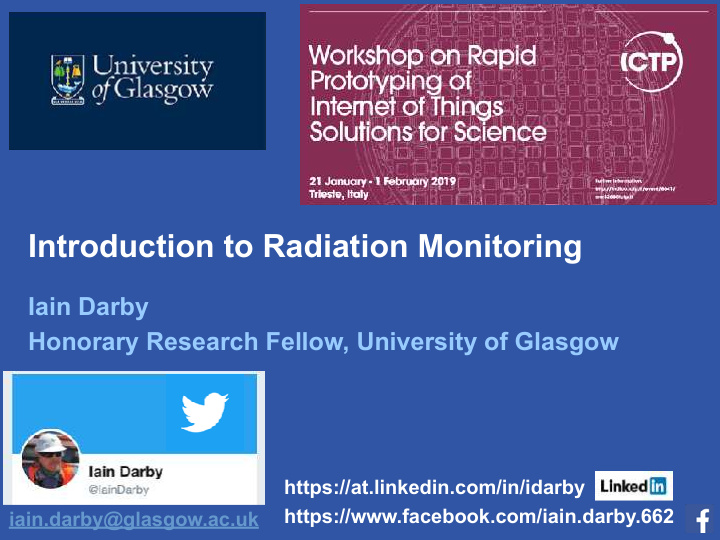



Introduction to Radiation Monitoring Iain Darby Honorary Research Fellow, University of Glasgow https://at.linkedin.com/in/idarby https://www.facebook.com/iain.darby.662 iain.darby@glasgow.ac.uk
Outline • My 3 Things! • NORM • Basic Physics • Statistics • Detectors
3 Things! #1 https://www.physicsforums.com/threads/ the-inverse-square-law.754756/ Attribution: Borb (Wikipedia) � 3
3 Things! #2 https://www.researchgate.net/publication/ 266453326_POLAR_-_space- borne_Gamma_Ray_Burst_polarimeter/figures?lo=1 Orig fig ref: The Atomic Nucleus, R.D. Evans 1955 � 4
3 Things! #3 http://www.epa.ie/radiation/monassess/mapmon/?stat=82&date=03-18 � 5
3 Things! #3 � 6 https://www.timeanddate.com/weather/ireland/dublin/historic?month=3&year=2018
What can we measure ? • A hit • The amount of energy in the hit • When the hit occurred • Perhaps • Where the hit occurred • If many hits occurred Put simply - ENERGY & TIME … that’s all folks!
Counting system example Geiger Muller Tube
Geiger Muller Geiger Muller By Zátonyi Sándor, (ifj.) Fizped - Own work, CC BY-SA 3.0, https://commons.wikimedia.org/w/index.php?curid=20517957
Geiger Muller � 10 By Svjo-2 - Own work, CC BY-SA 3.0, https://commons.wikimedia.org/w/index.php?curid=39176160
Geiger Muller � 11 By Dougsim - Own work, CC BY-SA 3.0, https://commons.wikimedia.org/w/index.php?curid=22417438
Geiger Muller Counter By Dougsim - Own work, CC BY-SA 3.0, https://commons.wikimedia.org/w/index.php?curid=22417438
Geiger Muller Counter By Dougsim - Own work, CC BY-SA 3.0, https://commons.wikimedia.org/w/index.php?curid=22417438
Geiger Muller � 14
Geiger Muller Counter By Dougsim - Own work, CC BY-SA 3.0, https://commons.wikimedia.org/w/index.php?curid=22417438
Geiger Muller � 16 By N.Manytchkine - Own work, CC BY-SA 3.0, https://commons.wikimedia.org/w/index.php?curid=817437
Geiger Muller � 17 By Zátonyi Sándor, (ifj.) Fizped - Own work, CC BY-SA 3.0, https://commons.wikimedia.org/w/index.php?curid=20517957
Geiger Muller � 18 By Dougsim - Own work, CC BY-SA 3.0, https://commons.wikimedia.org/w/index.php?curid=22417438
Spectrometer - “Energy Measurement” Scintillator
Basic interaction processes in crystals : (X-ray / γ radiation) • Photoelectric effect => Total absorption of γ -ray • Compton effect => photon energy partly absorbed • pair production (E > 1.02 MeV) Relative importance effects dependent on Z of material (crystal)
Various processes in scintillation detectors Pulse height spectrometry: Typical pulse height spectrum from scintillation crystal.
Energy resolution: the number of channels between the two points at half the maximum intensity of the photopeak, divided by the channel number of the peak mid-point, multiplied by 100%. Influenced by: 1. Intrinsic effective line width (non proportionality) 2. Photoelectron statistics 3. Light collection uniformity + PMT effects For low energies (e.g. 140 keV), contribution 2 and 3 most important.
Important characteristics of scintillators • Density and Atomic number (Z) • Light output intensity and wavelength • Decay time (duration of light pulse) • Mechanical and optical properties • Cost Often broad emission bands (mechanism)
Some principles and criteria : Photon detection : Density (mass) to allow certain efficiency 1. Spectroscopy requires photo-electric effect (higher Z) 2. Dynamic range in relation to decay time of scintillator : NaI(Tl) < 500 kHz YAP:Ce ~ 4 MHz Higher count rates problematic in counting mode � DC current mode Particle detection ( alphas/betas – heavy ions) 1. Optical window thickness ! ( mylar windows required) 2. Total absorption of heavy ions will provide peaks 3. Energy per MeV less than for photons, scintillator dependent (0.1 - 0.95)
Detection of scintillation light: A. 1. Photomultiplier Tubes 2. Semiconductor devices (photodiodes, APDs) 1. PMTs Photoelectron production In thin photocathode layers (e.g. Cs/Sb/K/Se) + electron mulitplication on Structure of dynodes via secundary emission. (Dynodes CuBe or Cs/Sb)
Focussing of electrons very important. • venetian blind (standard) • linear focuses (fast) • circular cage (inexpensive) • teacup (good PHR) • box-and-grid (simple) • proximity mesh (magnetic immunity) Choice depends on application. Temperature drifts of PMTs Gain drift of order 0.2% per degree K. Gain of a PMT not 100 % reproducible Max. gain or order 10 6
Advantages of PMTs: Disadvantages of PMTs: • high gain => large signal •fragile & bulky / recently: - low profile • standard devices - miniature • fast reponse •high voltage reguired (kVs) / recent developm. I integrated HV.suppl. • magnetic field sensitive • 40K backgroud from glass • gain drifts •Only sensitive < 600 nm Detector gain drift due to temperature effects : - Crystal - light detection device
Stabilisation: Radioactive pulsers (Alpha emitters) - LED pulsers - hardware stabilisation on peak - software stabilisation on peak
SEMICONDUCTOR DETECTORS • PIN photodiodes (standard) • Avalanche photodiodes (new in large areas) • Drift photodiodes (getting better and larger) • Silicon PMTs All above devices: compact, rugged and insensitive to magnetic fields Si High quantum efficiency in 500 nm area Overlaps well with emission CsI(Tl), CdWO4. Example pulse height spectrum of 662 Kev y -rays absorbed in an 18 x 18 x 25 mm CsI(Tl) crystal coupled to an 18 x 18 mm 2 photodiode.
Noise determines low energy limit e.g.: 10 x 10 x 10 mm CsI(Tl) + 10x10 mm PIN diode has lower energy limit of about 37 keV. Most important advantage of PIN photodiodes is their stability (calibration + resolution!) Noise is limiting factor for application Optimum wafer thickness is 200 – 300 µ m Main contribution to energy resolution (cm size diodes) is Capacitive noise diode/preamp Max. usable surface 28 x 28 mm high resistivity silicon + good quality / low noise preamps => low noise combination Si-photodiode/preamp. Typical noise: 10 x 10 mm 390 ENC (900 electrons) 18 x 18 mm 550 ENC (1300 electrons) 28 x 28 mm 1050 ENC (2500 electrons)
Very few crystals with high light output > 500 nm scintillator with the highest light yield > 500 nm is CsI(Tl). => 3 – 4 . 10 4 e-h pairs per MeV y -rays PIN SILICON PHOTODIODES. Properties: • No amplification (unity gain device) (therefore) Very stable signal • Low voltage operation • noisy • u s filtering necessary
Exercises Is this detector ok to use?
Teviso BG51
Exercises What’s the dose?
bGeigie Nano (LND 7317)
bGeigie Nano (LND 7317)
Exercises How do we set up a spectrometer with an energy range of 1.2 & 2.4MeV How would we cut off the energy to 2MeV For a strong source how could we cut the counting rate?
Recommend
More recommend